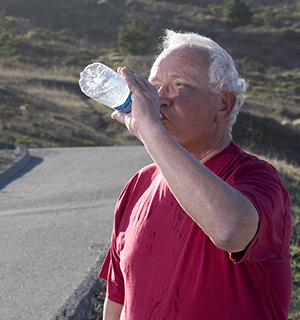Chronic Lung Disease: Tips for Safe Exercise
After you have met with your healthcare provider and set up an exercise plan, use these tips for better exercise. You can use them at your pulmonary facility or at home.
Get ready for your workout
Here's how to get ready:
-
Plan your workout for the time of day when you normally have the most energy.
-
Dress for comfort. Wear shoes that support your feet.
-
Use a bronchodilator if one has been prescribed. For best results, use it as prescribed by your healthcare provider before exercise or any other strenuous activity.
-
Clear your lungs of mucus if needed.
-
Use oxygen if it’s prescribed for use during activity. Increase the flow rate only if your healthcare provider has told you to. Raising it on your own can be unsafe.
-
Check the weather before you start. On warm or humid days, reduce your workout and rest more often. Also drink extra fluids. Exercise earlier in the day, before it gets hot. If it’s cold outside or if air quality is poor, exercise indoors. Walk inside your home or in a mall.
My starting goal is ________ minutes of exercise, ________ days a week.
Warm up and cool down
Here's what you can do before and after exercising:
-
To warm up, start with a few stretches. This gets your muscles ready for exercise.
-
After your stretches, move on to heavier activity. Pace yourself. Remember to breathe.
-
Toward the end of your workout, decrease your effort so your body can cool down. Then stretch again. This relaxes your muscles. It helps prevent soreness, too.
-
Rest and relax.
Stay safe during exercise

Tips for safe exercise:
-
Follow the guidelines your healthcare provider or pulmonary rehab team has set for you.
-
Pace yourself. Stop and rest when you need to.
-
Drink plenty of water before, during, and after exercise.
-
Remember that shortness of breath is OK, as long as you can talk and are in control of your breathing. Everyone gets short of breath during exercise—even people without chronic lung disease. But if you can’t speak, you’re pushing yourself too hard. If you have increased shortness of breath, slow down. If it continues, stop and rest.
-
Use pursed-lip breathing to control shortness of breath.
-
Keep your rescue inhaler with you. Use it if you need to.
Watch for signs of overexertion
Stop exercising right away and call your healthcare provider if you feel any of these:
-
Abnormal or increasing shortness of breath
-
Chest pain or discomfort (burning, tightness, heaviness, or pressure)
-
Aching in your arms, shoulder, neck, jaw, or back that is typical for you
-
A slightly racing or skipping heartbeat
-
Feeling much more tired than usual
-
Feeling slight lightheadedness, dizziness, confusion, or nausea
-
Abnormal joint pain
Call 911
Call 911 if you have any of these:
-
Abnormal, severe, or quickly worsening shortness of breath
-
Unusual or severe chest pain or discomfort (burning, tightness, heaviness, or pressure)
-
Abnormal aching in your shoulders, arm, neck, jaw, or back
-
Feeling very lightheaded or dizzy
-
A very fast or skipping heartbeat
-
Not able to talk
Online Medical Reviewer:
Chris Southard RN
Online Medical Reviewer:
Jessica Gotwals RN BSN MPH
Online Medical Reviewer:
Rajadurai Samnishanth Researcher
Date Last Reviewed:
4/1/2024
© 2000-2024 The StayWell Company, LLC. All rights reserved. This information is not intended as a substitute for professional medical care. Always follow your healthcare professional's instructions.